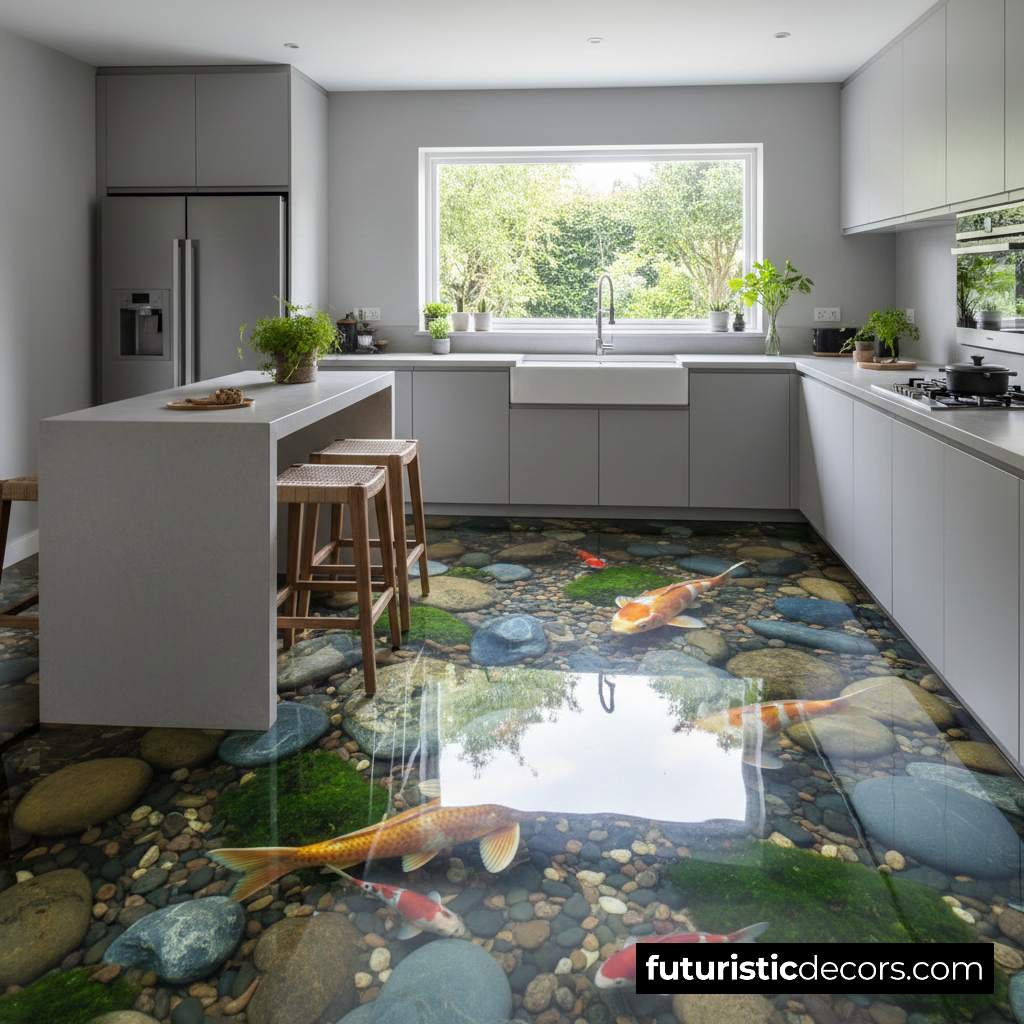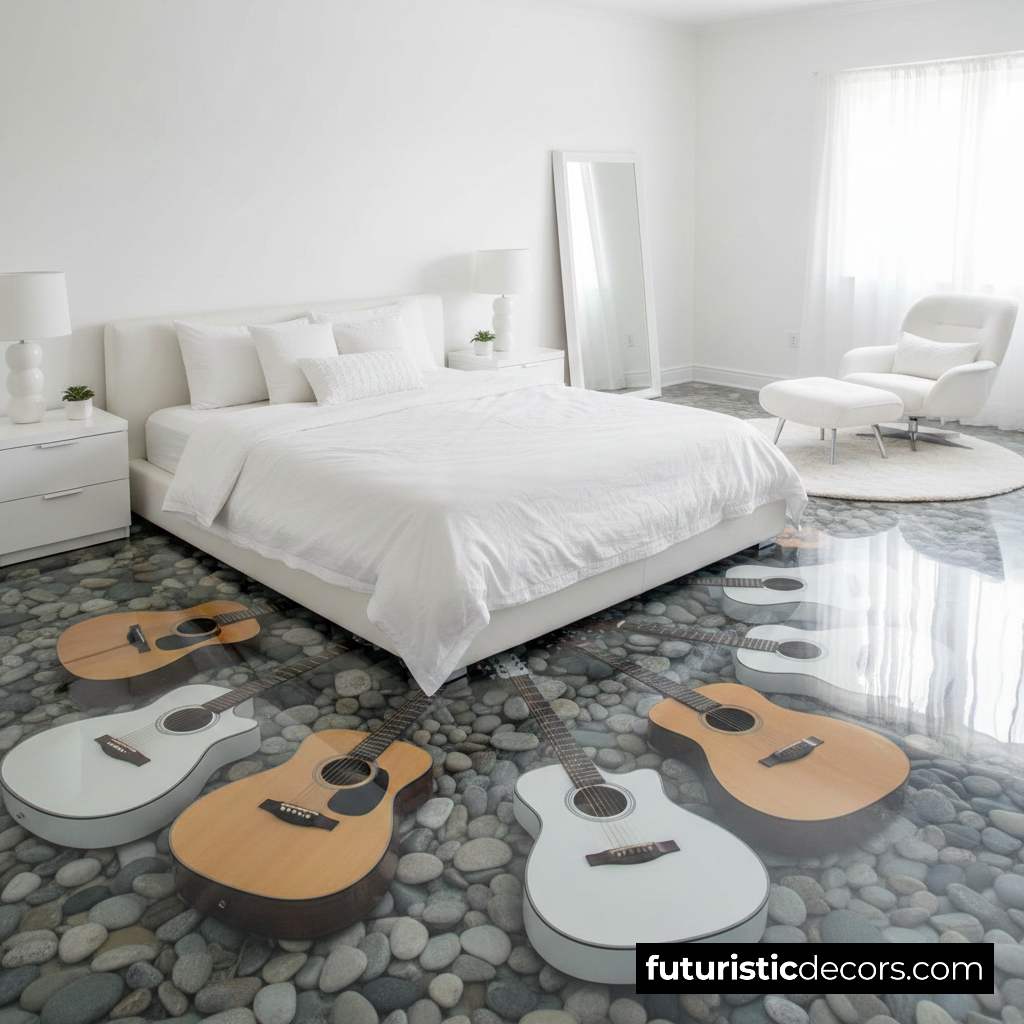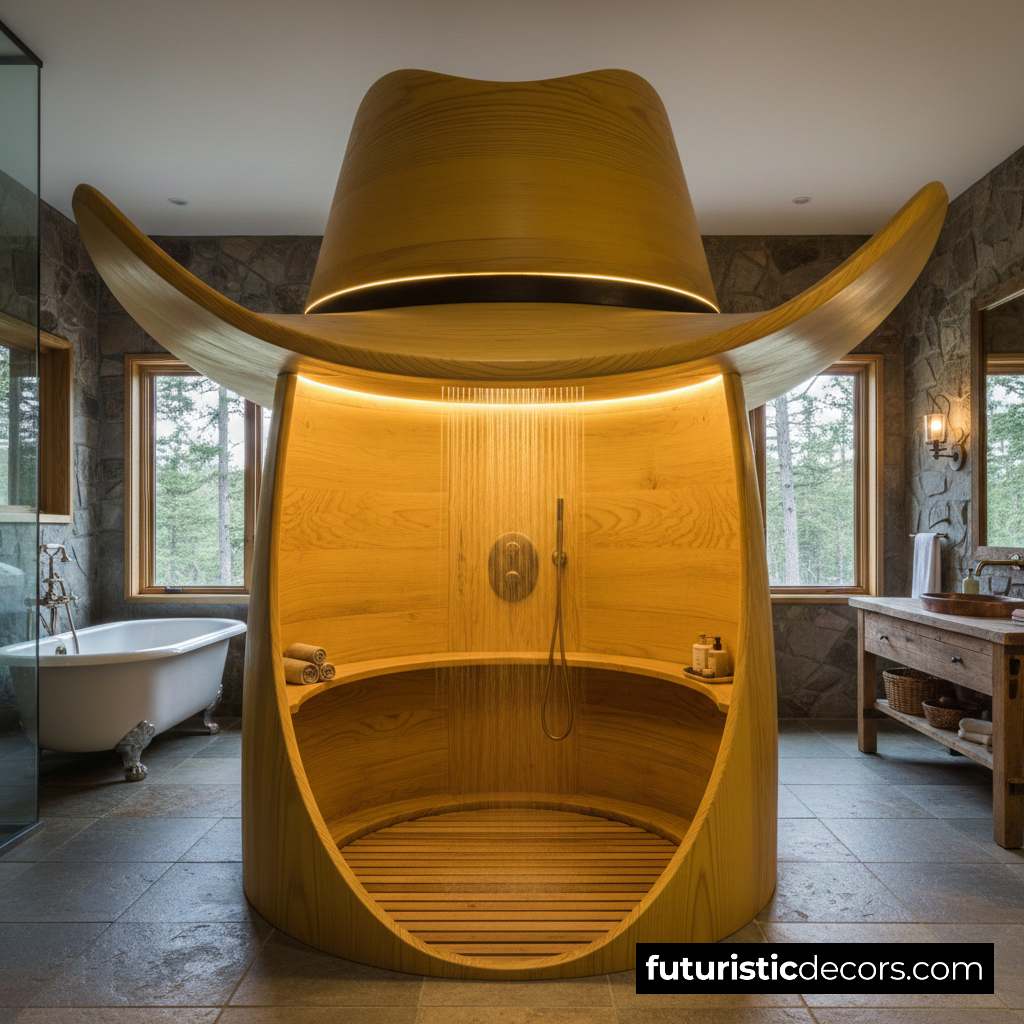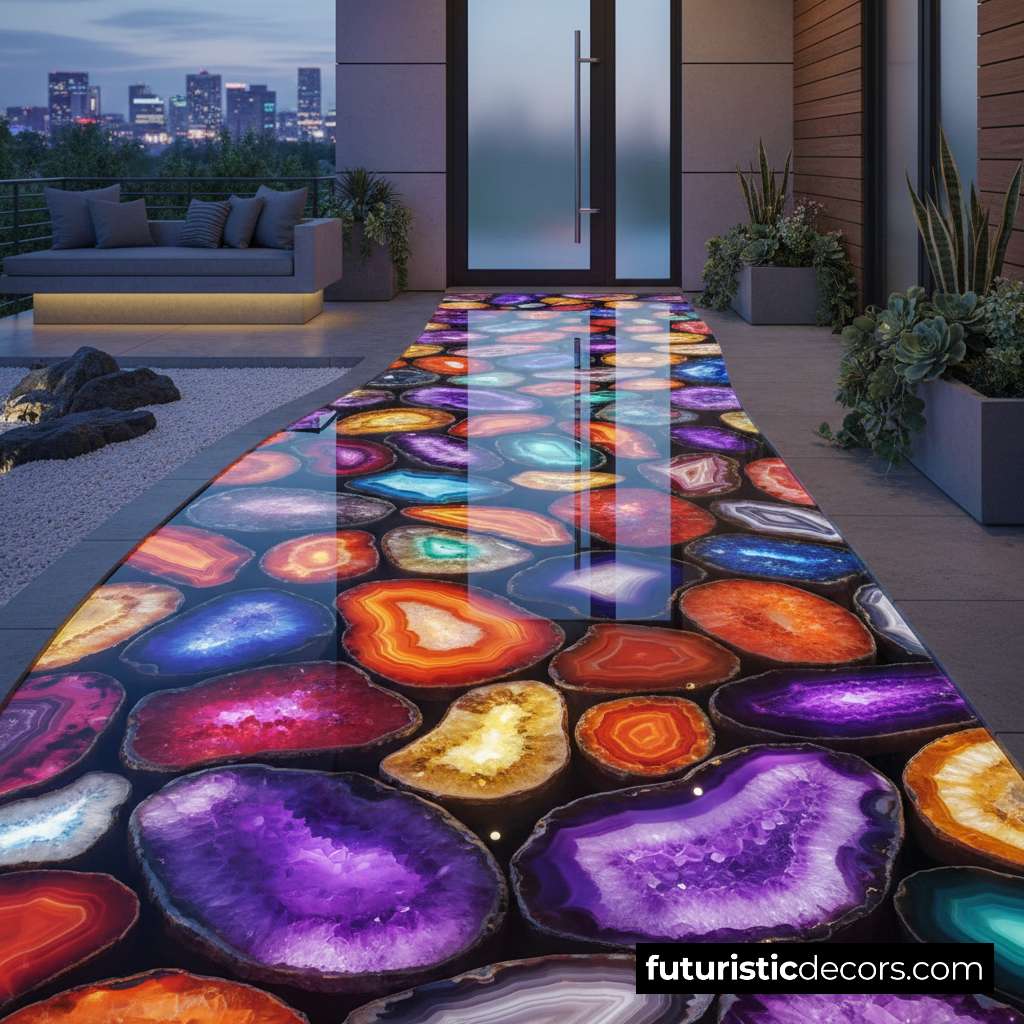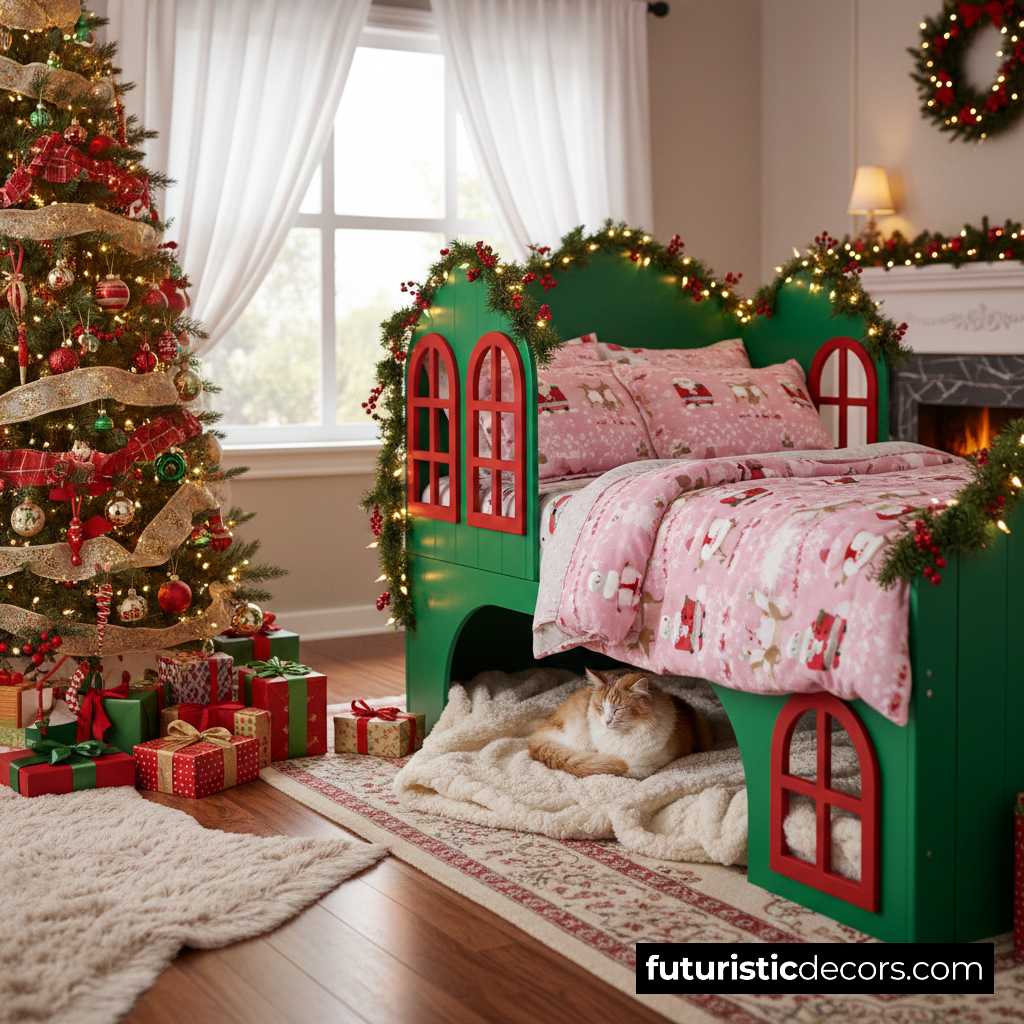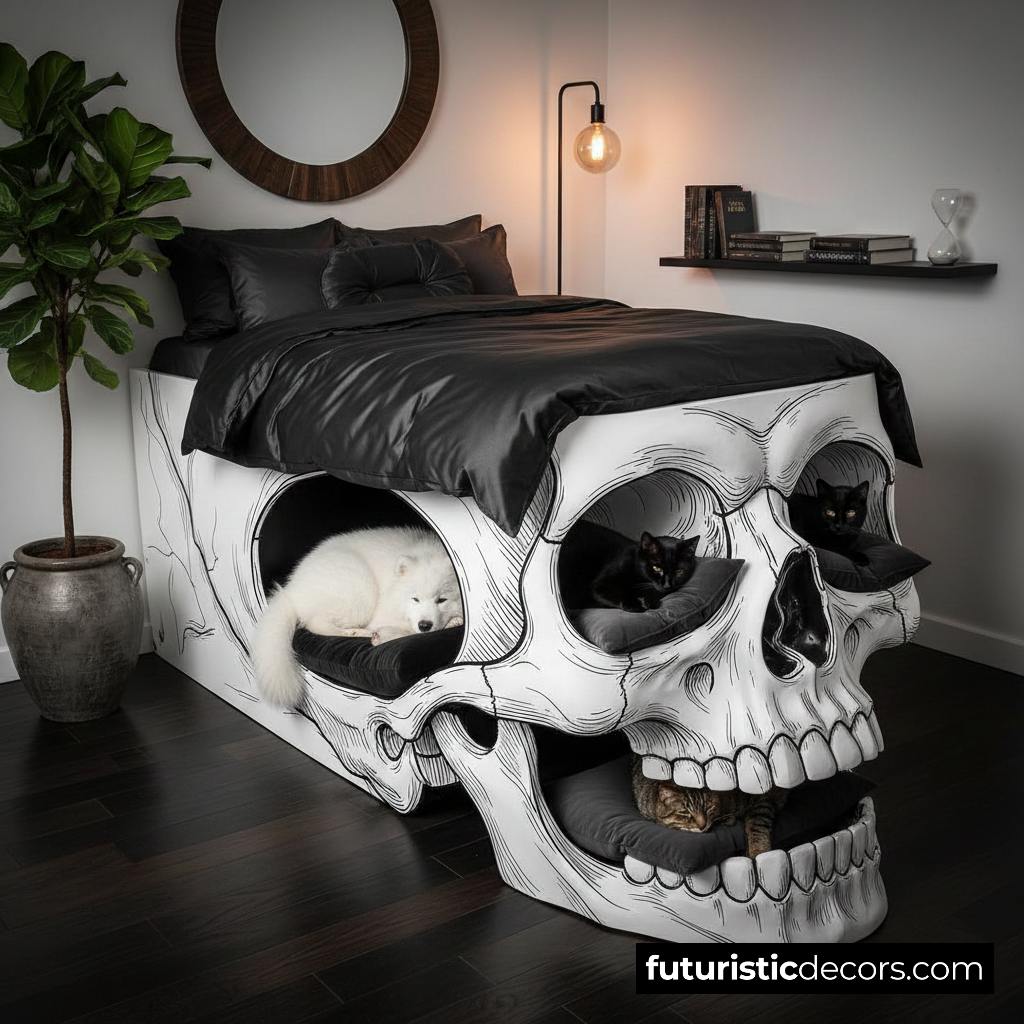For many homeowners, the garage is no longer just a place to park cars or store tools. It’s evolving into a man cave—a personalized retreat that reflects craftsmanship, creativity, and lifestyle. And at the heart of this transformation lies one surprisingly luxurious upgrade: epoxy wood garage flooring.
Blending the organic warmth of natural wood with the durability of high-performance epoxy, this innovative flooring trend gives garages a sleek yet earthy aesthetic. Imagine a surface that looks like freshly sliced logs frozen in clear resin—highly polished, reflective, and unbelievably strong. Whether you’re restoring a classic car, working on a DIY project, or just relaxing with friends, epoxy wood garage flooring sets the tone for a space that’s both rugged and refined.
What Is Epoxy Wood Garage Flooring?
Epoxy wood garage flooring combines wooden log slices or planks with a clear or tinted epoxy resin. Each wood piece is carefully dried and sealed to preserve its character—rings, cracks, bark textures—before being embedded in a thick, glossy layer of epoxy. Once cured, the resin hardens into a glass-like surface that protects the wood while offering the incredible resilience epoxy is known for.
The result is a stunning, natural-meets-industrial aesthetic: the warmth of timber beneath a tough, reflective, and maintenance-free surface. It’s art, architecture, and engineering all fused into one.
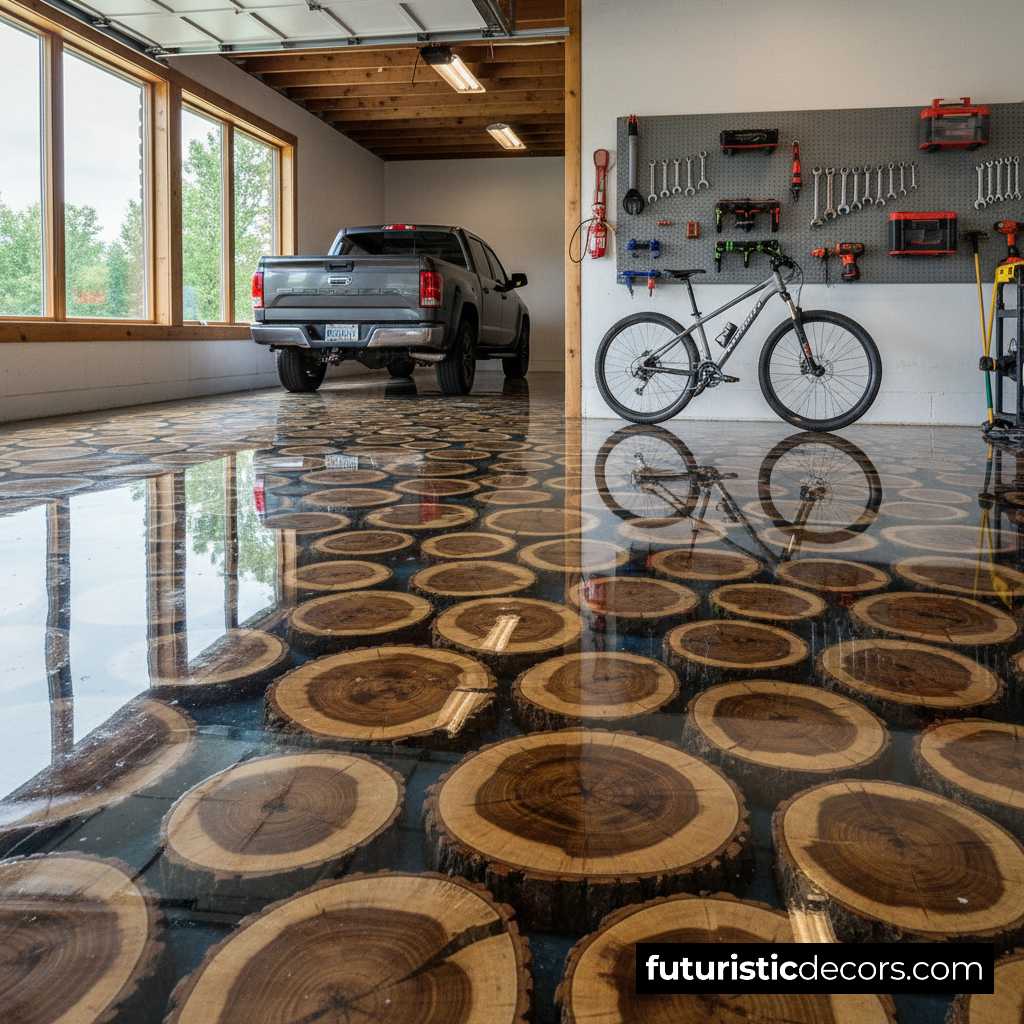
Why Epoxy Wood Flooring Is Perfect for a Man Cave Garage?
A man cave should mirror your personality, and epoxy wood garage flooring delivers both style and substance. Here’s why it’s an ideal upgrade:
A Bold Visual Statement
This flooring instantly commands attention. The log-end patterns, swirling epoxy tones, and glassy reflection create depth and texture that elevate any garage from utilitarian to designer-grade.
Unmatched Durability
Epoxy is engineered for strength. It resists oil stains, tire marks, and chemical spills. Paired with hardwood slices, it provides both toughness and organic charm—perfect for spaces where heavy vehicles or machinery are used.
Low Maintenance, High Reward
Unlike untreated concrete or painted surfaces that chip or stain, epoxy requires minimal care. A simple sweep and occasional mop keep the floor spotless. No need for waxing or refinishing.
Personalization
You can customize epoxy wood garage flooring with wood species, resin colors, or embedded metallic pigments to match your vehicle, decor, or overall man cave theme.
Eco-Friendly Appeal
Repurposing wood slices—often from reclaimed timber or fallen logs—adds sustainability to your renovation. It’s a statement of craftsmanship and environmental consciousness.
Design & Aesthetic Appeal
Few flooring designs can compete with the visual drama of epoxy wood garage flooring. The combination of natural wood and resin produces a look that’s both rustic and futuristic.
- Rustic Charm: Exposed growth rings and bark edges highlight the raw beauty of nature.
- Contemporary Gloss: The clear epoxy topcoat adds modern sleekness and amplifies light reflection.
- Custom Epoxy Colors: You can use smoky grays, deep ambers, or metallic flakes to achieve distinct moods—from industrial chic to cozy cabin warmth.
- Visual Depth: The transparent resin gives a three-dimensional illusion, making each wood slice look like it’s floating.
This flooring doesn’t just beautify the garage—it transforms it into an art installation you can walk (and park) on.
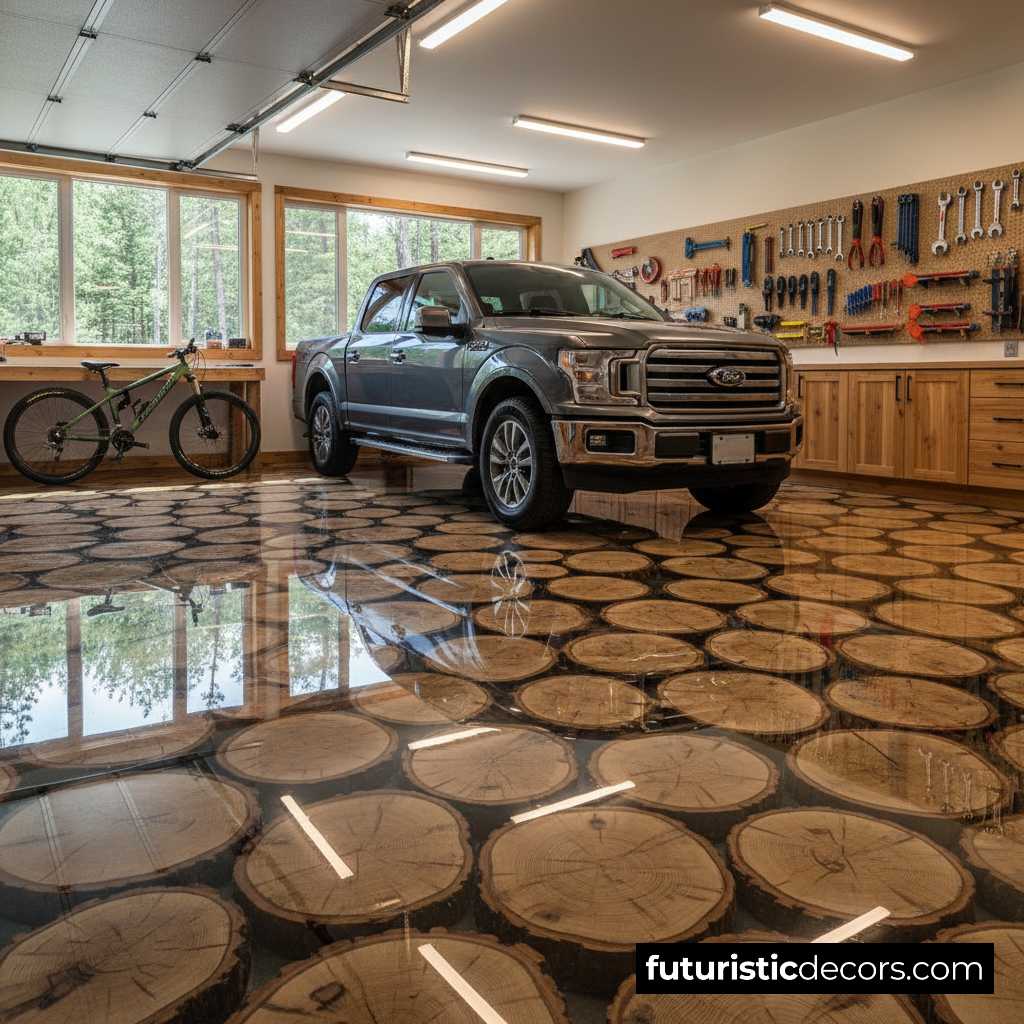
Epoxy Wood Garage Flooring: Variants & Customization Options
The beauty of epoxy wood garage flooring lies in its infinite design flexibility. Homeowners can personalize every element to align with their creative vision.
1. Wood Species
- Oak or Walnut: For darker, luxurious tones.
- Pine or Birch: For lighter, Scandinavian-inspired looks.
- Cedar or Redwood: Adds natural aroma and rich warmth.
2. Log Slice vs. Plank Layout
- Log Slice Design: Circular cross-sections highlight growth rings.
- Plank Layout: Linear wood strips under epoxy create a smoother, contemporary effect.
3. Epoxy Color and Depth
- Clear Gloss: Pure transparency for a glass-floor illusion.
- Tinted Resin: Slight gray, amber, or black hues to complement garage lighting.
- Metallic Epoxy: Adds shimmering particles that mimic liquid metal beneath the surface.
4. Edge Detailing
Some installers preserve bark edges for a rugged, natural look, while others sand them for a refined finish.
5. Embedded Elements
Add your initials, LED lighting, or small metallic inlays beneath the epoxy layer for a signature, one-of-a-kind man cave design.
Materials & Durability
The Wood
The wood used in epoxy wood garage flooring must be properly dried, sealed, and stabilized. Moisture control is critical to prevent warping or resin separation. Hardwoods like oak, maple, and walnut are favorites due to their density and distinct ring patterns.
The Epoxy Resin
Garage-grade epoxy is a two-part thermosetting resin that creates an incredibly tough surface once cured. It’s resistant to:
- Oil, fuel, and chemical spills
- Hot tire pickup
- Scratches and abrasions
- Moisture and temperature fluctuations
Layering System
A professional installation typically involves:
- Concrete base preparation (grinding and cleaning)
- Primer coat for adhesion
- Placement of wood slices or planks
- Pouring of clear epoxy layers (often multiple coats)
- UV-resistant topcoat for long-term clarity
The final finish can last decades with minimal maintenance—an investment in both aesthetics and functionality.

Installation & Compatibility: Epoxy Wood Garage Flooring
Installing epoxy wood garage flooring is an art that balances precision and patience. It’s not a typical DIY job unless you’re experienced with resin systems. Here’s a look at how it’s done:
Surface Preparation
Concrete must be clean, level, and free of dust or grease. This ensures proper epoxy adhesion. Grinding or shot blasting is often required.
Moisture Barrier
An epoxy primer or vapor barrier prevents moisture from seeping through the concrete and damaging the finish.
Wood Placement
Pre-treated wood slices are arranged in patterns across the floor. The gaps between pieces are intentionally varied to allow resin flow.
Pouring the Epoxy
Clear epoxy is poured in multiple layers to encapsulate the wood. Each layer is cured before the next is added, creating depth and transparency.
Final Curing & Polishing
After full curing (typically 48–72 hours), the surface is polished to a glass-like sheen. Anti-slip additives can be included for safety if desired.
DIY vs Professional Installation
If you’re a hobbyist with resin experience, small sections of epoxy wood garage flooring can be a DIY weekend project. However, full-scale installations—especially for garages with vehicle load—require professional expertise.
DIY Installation – Benefits & Ideal Situations
Pros
- Cost-saving: By handling the labor yourself, you save on contractor fees. This makes DIY appealing if you’re budget-conscious.
- Creative control: You pick all the materials, design details (wood types, epoxy tints, layout), and manage the schedule.
- Personal satisfaction: Completing a project yourself can be highly rewarding, especially if you enjoy hands-on work and craftsmanship.
Best for when:
- The garage is moderate in size and usage (e.g., hobby/workshop, not heavy‐truck parking).
- You have some experience with flooring or resin work, and access to tools (concrete grinder, vacuum, resin sprayer/roller).
- The substrate (concrete + wood slices) is in good condition—all major cracks repaired, minimal moisture issues.
- You’re okay committing the time and effort: prep work, curing times, and careful application.
Key steps you’ll need to manage:
- Concrete surface preparation: cleaning, degreasing, repairing cracks, grinding or etching to ensure proper bonding.
- Wood slice (or plank) drying, sealing and layout before epoxy pour.
- Mixing and applying resin layers, ensuring no bubbles, maintaining wet edges, layering to the right thickness.
- Curing the epoxy thoroughly before use.
- Maintenance planning.
Tip: If doing DIY, allow extra time for unexpected issues (moisture, floor flatness, mix errors) and always use quality resin systems rated for garage/vehicle use.
Professional Installation – Benefits & When It’s Best
Pros
- Expertise & execution: Pros handle all prep, have the right equipment (grinders, vacuums, professional resin systems), know how to manage issues like moisture or slab defects, and deliver high-quality finishes.
- Better materials & processes: Commercial-grade epoxy systems, proper adhesion primers, multiple coats layered and cured under ideal conditions.
- Efficiency & less hassle: The project is managed for you — you schedule, the team comes in, completes work, and you get a polished floor with minimal personal disruption.
- Warranty and long-term value: Many professional installs come with warranties or guarantees, giving you greater peace of mind.
Best for when:
- You’re using the space for heavy vehicles, high traffic, or want a showroom-grade finish.
- The floor substrate requires serious remediation (cracks, moisture, uneven surfaces).
- Your time is limited, or you prefer a turnkey solution.
- You want the maximum lifespan and minimal risk.
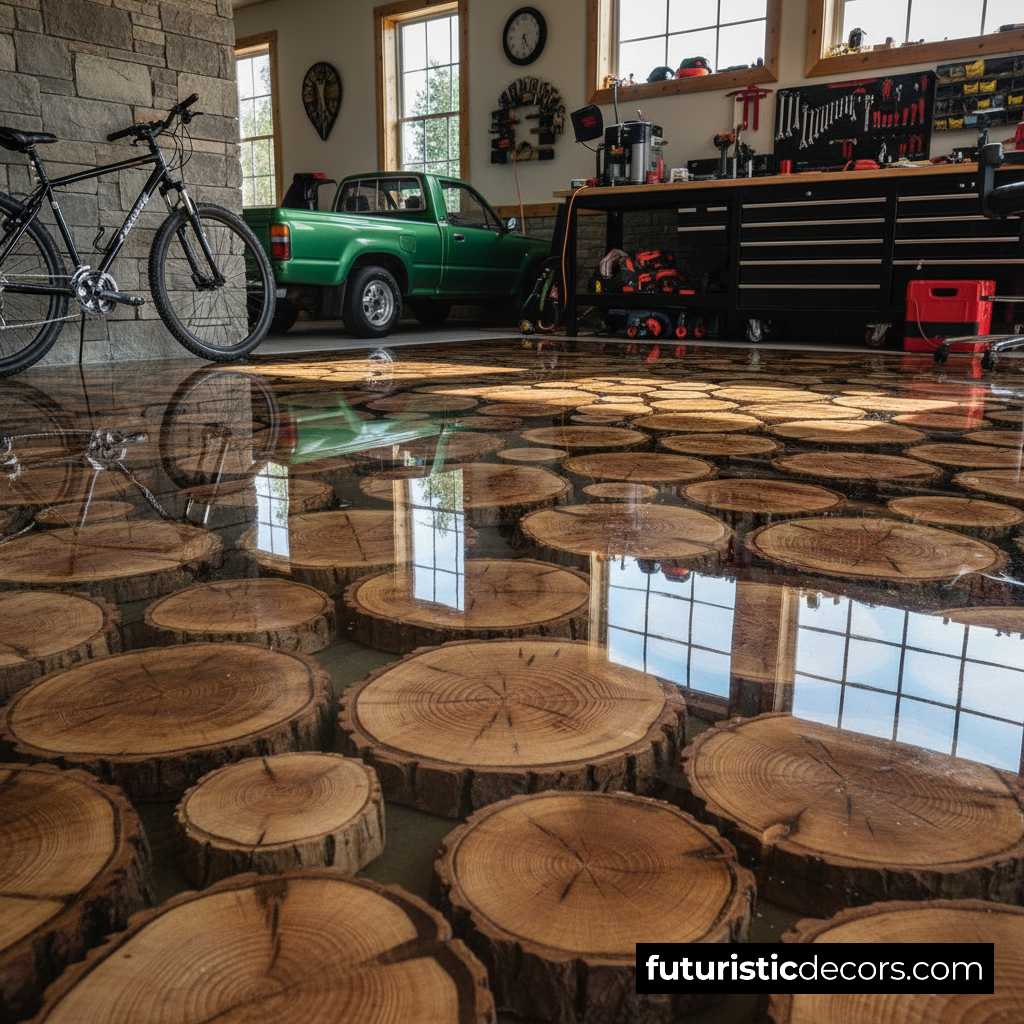
Price Range 2025 Guide
The cost of epoxy wood garage flooring depends on materials, design complexity, and installer experience.
| Type | Estimated Price (USD per sq.ft.) | Description |
|---|---|---|
| Basic Epoxy Overlay | $5 – $8 | Standard clear epoxy on prepared concrete |
| Epoxy with Log Slices | $12 – $20 | Natural wood embedded in resin |
| Premium Custom Design | $20 – $30+ | Metallic resin, LED effects, or branded patterns |
A typical two-car garage (400–450 sq.ft.) can range from $5,000 to $12,000, depending on customization. While not the cheapest flooring option, the visual impact and durability justify the investment.
Link to buy similar products: Click here
Epoxy Wood Garage Flooring: Sustainability & Eco Impact
Beyond aesthetics, this flooring choice reflects a growing movement toward sustainable design. By using reclaimed or storm-fallen timber slices, homeowners reduce waste and repurpose natural materials. The long life span of epoxy coatings also minimizes the need for replacement, lowering overall material consumption.
Choose low-VOC or bio-based epoxies to further enhance eco-credentials—proving that luxury design and environmental responsibility can coexist.
FAQs about Epoxy Wood Garage Flooring
1. Can epoxy wood flooring handle the weight of cars and trucks?
Absolutely. Garage-grade epoxy is engineered to withstand vehicle weight, tire friction, and impact without cracking or denting.
2. Will the wood expand or rot inside the resin?
No. Properly dried and sealed wood is fully encapsulated in epoxy, making it waterproof and stable.
3. How long does installation take?
Depending on size and design complexity, professional installation typically takes 3–5 days including curing time.
4. Can I customize the epoxy color or pattern?
Yes. You can choose from clear, tinted, or metallic epoxy and even add pigments, glitter, or embedded decor under the topcoat.
5. Is it slippery when wet?
Epoxy surfaces can be made slip-resistant with a fine grit additive in the final coat.
6. Can existing garage floors be converted to epoxy wood designs?
Yes. Most concrete bases can be resurfaced and coated with this system as long as they are structurally sound and moisture-free.
Conclusion: Redefine Your Garage with Artistic Strength
Transforming your garage into a true man cave doesn’t require tearing down walls or buying expensive decor. Sometimes, it’s the floor beneath your feet that makes the boldest statement. Epoxy wood garage flooring bridges the gap between nature and technology, offering beauty, resilience, and personal flair that lasts for decades.
From its mirror-like surface to its natural log textures, every inch radiates craftsmanship. Whether you want to show off your car collection, create a workshop masterpiece, or just enjoy a space that feels uniquely yours, this flooring revolution is your next upgrade. Bring life, warmth, and art to your man cave—one epoxy-sealed wood slice at a time.



